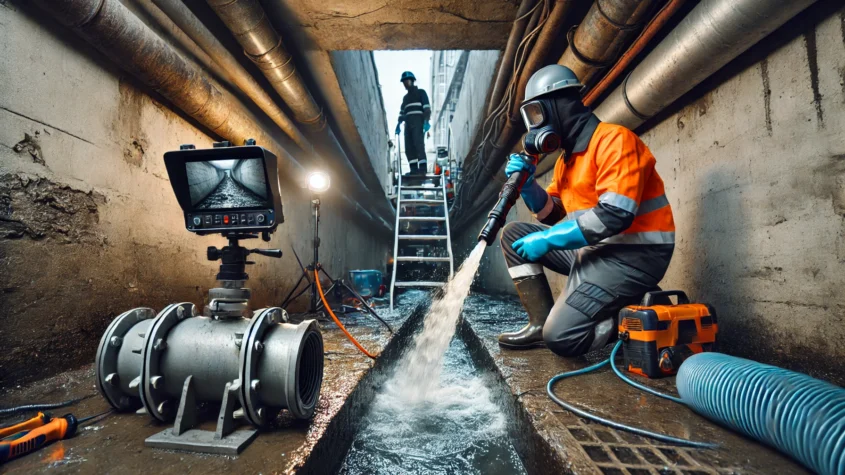
Drain camera inspections are a modern solution for identifying and diagnosing plumbing issues without invasive methods. This technique utilizes a high-resolution camera attached to a flexible cable, which is inserted into the drain system. These inspections provide accurate assessments of the condition of pipes, allowing for timely and effective repairs.
Homeowners and property managers often face unexpected plumbing complications. By choosing drain camera inspections, they can save time and money by pinpointing the exact problem without unnecessary digging or damage. This proactive approach not only facilitates repairs but also helps maintain the efficiency of the plumbing system.
Understanding what drain camera inspections entail is essential for anyone dealing with plumbing issues. By shedding light on the inner workings of pipes, these inspections offer valuable insights that contribute to informed decision-making regarding property maintenance.
Basics of Drain Camera Inspections
Drain camera inspections utilize specialized equipment to assess the condition of drainage systems. This method offers detailed insights into issues without extensive excavation or disruption. The following sections explore the equipment used, the inspection process, and the benefits that such inspections provide.
Equipment and Tools Used
Drain camera inspections rely on advanced equipment, primarily a flexible, waterproof camera attached to a long cable. The camera provides high-resolution images and videos, allowing technicians to see inside pipes in real-time.
Key tools include:
- Push Cameras: Compact and easy to maneuver, ideal for smaller pipes.
- Crawler Cameras: Used for larger pipes, featuring tracked wheels for stable navigation.
- High-Definition Monitors: Display live footage, enhancing visibility.
- Recording Equipment: Captures video for documentation and future reference.
The selection of tools is pivotal for effective inspections in various pipe sizes and conditions.
Understanding the Process
The process begins with the technician accessing a cleanout or drain opening. The camera is carefully fed into the pipe, maneuvering through its twists and turns.
Once inside, the camera sends real-time footage to a monitor. This enables immediate identification of blockages, cracks, or other issues within the drainage system.
Technicians analyze the visual data, mapping out the pipe’s condition and determining the necessary actions. This eliminates guesswork and allows for a more informed approach to repairs.
Key Benefits of Camera Inspections
Drain camera inspections offer numerous advantages for property owners and maintenance professionals. One of the primary benefits is the accuracy in diagnosing problems without invasive methods.
Additional benefits include:
- Cost-Effective Solutions: Precise identification of issues helps prevent costly repairs caused by prolonged damage.
- Non-Destructive Testing: Inspections can be performed without disrupting landscaping or property structures.
- Comprehensive Documentation: Recorded footage provides a clear reference for future maintenance or repairs.
These benefits streamline the inspection process, leading to efficient and effective drainage management.
Performing a Drain Camera Inspection
Drain camera inspections involve a series of methodical steps that ensure a thorough evaluation of the plumbing system. The following sections outline essential preparation steps, inspection techniques, and interpretation of results, along with identifying common issues.
Preparation Steps
Prior to a drain camera inspection, it is crucial to prepare the area and equipment. Begin by clearing any obstacles around access points such as cleanouts. This allows for easy access for the camera equipment.
Next, choose the right equipment. Typically, a high-resolution camera attached to a flexible rod is used. Ensuring the camera is in good working order is imperative. Check batteries and connections beforehand.
Gather essential tools such as a flashlight, measuring tape, and route maps of the plumbing system. These will aid in navigating the inspection and recording findings.
Inspection Techniques
During the inspection, the camera is inserted into the drain through a cleanout or inspection opening. The operator carefully maneuvers the camera through the pipes, noting any obstacles or deviations in the pipe structure.
Live video feed allows real-time observation, enabling quick adjustments or direction changes as needed. The inspector should take notes on significant findings, such as diameter changes in the pipe or bends.
It’s important to document the distances traveled within the drain and any visual anomalies. This information aids in future plumbing decisions and repairs.
Interpreting the Results
Analyzing the footage captured during the inspection is critical. Inspectors should look for key indicators of plumbing issues, including cracks, blockages, or root intrusions.
The condition of the pipe material can also be assessed. For instance, older pipes may show signs of corrosion, while newer materials may present fewer issues.
Any unusual shapes in the footage may indicate improper installation or shifts in the ground. Identifying these nuances assists in determining the necessary repairs or maintenance.
Common Issues Identified
Several common problems may arise during a drain camera inspection. Clogs due to grease buildup, hair, or foreign objects are prevalent. Identifying the specific cause of a blockage is essential for targeted cleaning.
Cracks or breaks in the pipe can lead to leaks and must be repaired immediately to prevent further damage. Also, tree root intrusions can show up on camera. These roots can obstruct flow and damage plumbing.
Lastly, misalignments or sagging pipes may indicate ground movement. Addressing these issues promptly is key to maintaining plumbing system integrity.
Dumpster Near Me: Find the Best Local Rental Options for Your Needs
Finding a dumpster near me can streamline your cleanup efforts, whether it’s for a h…









